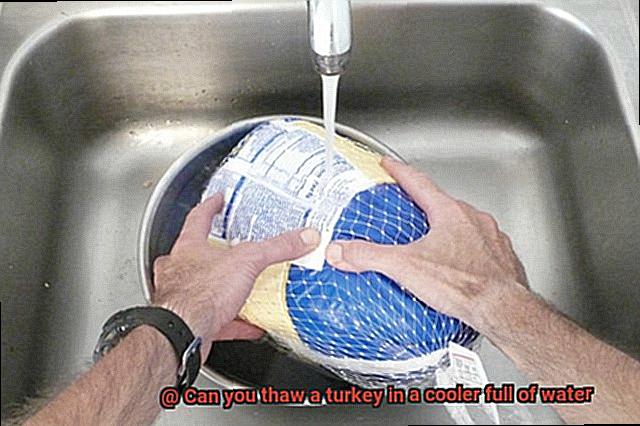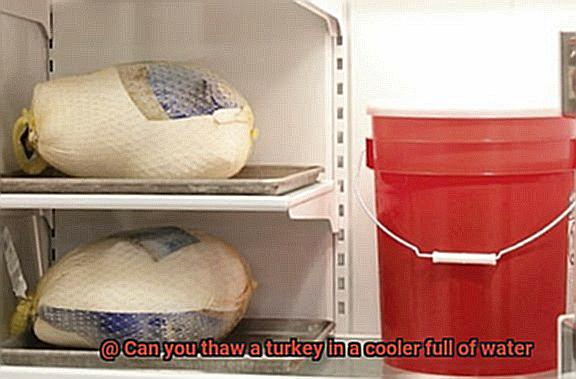The holiday season is upon us, and with it comes the joy of family gatherings, the aroma of scrumptious food wafting through the air, and of course, the star of the show – the turkey. However, if you’re in charge of hosting this year’s big feast, there’s one task that can be a cause for concern: thawing the turkey. It’s a delicate process that requires attention to detail and careful planning.
Luckily, there’s a new method that has gained popularity in recent years – thawing a turkey in a cooler full of water. This technique promises quicker thaw times than traditional methods like using the refrigerator, giving you more flexibility in your holiday preparations. But here’s the burning question: is it safe? Can you properly thaw your turkey using this method without risking foodborne illness?
In this article, we’ll explore everything you need to know about thawing your turkey in a cooler full of water. We’ll delve into all the steps involved in this method – from ideal water temperature to monitoring your bird’s temperature during defrosting. We’ll also address any warnings or precautions you should take while undertaking this process. By the end of this article, you’ll have all the facts and knowledge needed to decide whether or not this method is right for you and your holiday meal preparations. So let’s get started on our journey to learn about thawing turkey in a cooler full of water.
Contents
What Are the Risks Involved with Thawing a Turkey in a Cooler Full of Water?
Thawing a turkey in a cooler full of water may seem like an easy and efficient method, but it is crucial to understand the risks involved and how to do it safely.
One of the biggest risks of thawing a turkey in a cooler full of water is the potential for bacterial growth. If the water temperature is not kept below 40°F, bacteria like Salmonella and Campylobacter can multiply rapidly, leading to foodborne illnesses. To avoid this risk, it’s essential to use a thermometer to monitor the water temperature regularly and add ice or cold water if needed to keep it below 40°F.
Another significant risk is cross-contamination. If the water used to thaw the turkey comes into contact with other foods or surfaces, it can spread harmful bacteria throughout your kitchen and increase the risk of foodborne illness. Therefore, make sure to sanitize the cooler and any surfaces that come into contact with the water or turkey to prevent the spread of bacteria.
Uneven thawing can also occur if the turkey is not completely submerged in water. This can lead to some parts of the turkey remaining frozen, increasing the risk of bacterial growth and making it challenging to cook evenly.
Here are five steps you can follow to safely thaw your turkey in a cooler full of water:
- Ensure that the turkey is entirely submerged in cold tap water.
- Keep the water temperature below 40°F by monitoring it closely and adding ice or cold water as needed.
- Change out the water every 30 minutes to ensure it stays cold and fresh.
- Sanitize the cooler and any surfaces that come into contact with the water or turkey.
- Allow 30 minutes of thawing time per pound of turkey.
Remember, thawing a turkey at room temperature is not safe and should be avoided. The refrigerator is the safest method for thawing a turkey, but cold water can be used as an alternative if necessary.
How to Ensure Proper Water Temperature for Safe Thawing

Thawing a turkey can be a challenge, but using a cooler full of water is a popular method that can save time. However, it’s imperative to guarantee that the water temperature stays within a safe range to avoid any potential health risks. Here are five sub-sections explaining how to ensure proper water temperature for safe thawing when using a cooler full of water.
Monitor Water Temperature Regularly
To ensure that the water temperature remains safe, it’s important to use a food thermometer and check it regularly. The ideal temperature range for thawing poultry is between 40°F and 70°F. The thermometer should be placed in the turkey’s thickest part and not touch any bones or the bottom of the cooler. If the water temperature rises above 70°F, add more ice to cool it down and warm water if it drops below 40°F.
Keep Track of Turkey Size and Water Amount
The turkey size and amount of water in the cooler can affect the water temperature. A larger turkey will take more time to thaw and may raise the water temperature, while a smaller turkey will thaw faster and may lower the water temperature. Adding more or less water can also affect the water temperature, so it’s crucial to monitor it closely.
Store Cooler in a Cool, Dry Place
The cooler should be kept in a cool, dry place away from direct sunlight or other heat sources. This will prevent the water temperature from rising too quickly and ensure that the turkey thaws safely.
Replace Water if Necessary
If the water temperature rises above 40°F, replace the water with fresh, cold water immediately. This will help prevent bacterial growth and ensure even thawing of the turkey.
Never Thaw at Room Temperature
It’s crucial to note that thawing a turkey at room temperature is not safe as harmful bacteria can grow quickly. Thawing in the refrigerator is the safest method, but if using a cooler full of water, ensure that the water temperature stays within a safe range.
Monitoring the Water Temperature for Safe Thawing
It requires caution and attention to detail. So, how do you ensure safe thawing by monitoring the water temperature?
Firstly, it is crucial to understand that the danger zone for bacterial growth is between 40°F and 140°F. Any temperature within this range could lead to severe foodborne illnesses. Hence, monitoring the water temperature becomes a critical aspect of thawing.
To start, equip yourself with a thermometer, either digital or analog, with a long probe to reach the center of the turkey. Fill the cooler with cold water and check the water temperature using your thermometer before placing the turkey in it. If the water temperature is above 40°F, add ice to lower it. You can also replace some of the water with ice water to maintain consistency.
Once you have placed the turkey in the cooler, check the water temperature every hour and add more ice if necessary. Remember to keep the turkey fully submerged in the water at all times for even thawing and better temperature control. Do not hesitate to discard the turkey immediately if you notice any signs of spoilage or an off smell.
Here’s a quick list of steps to monitor the water temperature when thawing a turkey in a cooler:
- Use a thermometer with a long probe to reach the center of the turkey.
- Fill the cooler with cold water and check the temperature with your thermometer.
- Add ice if necessary to lower the water temperature below 40°F.
- Replace some of the water with ice water to maintain consistency.
- Check the water temperature every hour and add more ice if needed.
- Ensure that the turkey remains fully submerged in the water at all times.
- Discard the turkey immediately if you notice any signs of spoilage or an off smell.

The Dangers of Thawing at Room Temperature
While it may seem like a convenient option, it can actually pose serious health risks. As an expert on the dangers of thawing at room temperature, I can tell you why this method is not recommended.
To start, when a frozen turkey is left out to thaw at room temperature, the outer layer thaws first, creating a warm and moist environment that is ideal for bacterial growth. Bacteria such as Salmonella, Campylobacter, and E. coli thrive in such conditions and can cause severe illnesses like diarrhea, vomiting, fever, and dehydration. These infections are especially dangerous for vulnerable populations such as young children, elderly people, pregnant women, and those with weakened immune systems.
Furthermore, thawing a turkey at room temperature takes a considerable amount of time. A 20-pound turkey can take up to 5 days to thaw completely at room temperature. During this time, the bacteria on the outer layer have plenty of opportunities to multiply and spread throughout the meat – increasing the risk of foodborne illnesses and compromising the quality of your Thanksgiving meal.
So what’s the solution? Don’t take any chances with your health or your feast – avoid thawing your turkey at room temperature. Instead, opt for safer and more efficient thawing methods such as using a refrigerator or submerging the turkey in cold water.
Here are some additional tips to ensure safe thawing:
- Allow enough time for your turkey to thaw based on its weight. Plan ahead.
- If using a refrigerator, place the turkey on a tray or pan to catch any drips.
- If using cold water, change the water every 30 minutes to keep it at a safe temperature.
- Always wash your hands before and after handling raw poultry to prevent cross-contamination.
Refrigerator Method: The Safest Way to Thaw a Turkey
As the holidays approach, many of us are planning to serve turkey as the centerpiece of our festive meals. But did you know that how you thaw your turkey can impact its safety and taste? That’s why as an expert on the topic, I highly recommend using the refrigerator method – not only is it the safest way to thaw your turkey, but it also ensures the best flavor.
Here’s why:
- Minimizes bacterial growth: Bacteria can grow rapidly in warm and moist environments, which is why thawing a turkey at room temperature or with hot water can create ideal conditions for them to multiply. The refrigerator method thaws the turkey slowly over a few days, keeping the outer layer of the turkey at a safe temperature to prevent bacterial growth. This reduces the risk of foodborne illness and ensures your holiday meal is safe for everyone.
- Easy to do: Thawing a turkey in the refrigerator is a straightforward process. Simply remove the frozen turkey from its packaging, place it on a tray or plate to catch any drips, and place it in the lowest part of your refrigerator. Make sure there is enough space for air to circulate around the turkey, and let time do its work.
- Consistent temperature: Your refrigerator is designed to keep food at a consistent and safe temperature, making it an ideal environment for thawing your turkey. By using this method, you don’t have to worry about constantly monitoring the temperature like you would with other methods. This ensures that your turkey thaws evenly and stays safe throughout the process.
- Plan ahead: While it may take several days for a large turkey to thaw completely in the refrigerator, planning ahead will ensure that your turkey is fully thawed and ready for cooking when you need it. There’s no need to rush or worry about last-minute thawing emergencies.
Using the refrigerator method may take longer than other methods, but it’s worth it for the peace of mind knowing that you’re reducing any potential health risks. However, if you’re short on time, there are other methods available such as the cold water or microwave method – just make sure to follow all safety guidelines and instructions carefully.
Cold Water Method: A Faster Alternative to Refrigerator Method
To use this method, simply submerge your frozen turkey in a cooler filled with cold water and change the water every 30 minutes until it’s completely thawed. Depending on the size of your turkey, this process can take anywhere from 2-6 hours.
One major advantage of using the cold water method is that it can save you time compared to the refrigerator method, which can take several days. So, if you suddenly realize you forgot to take your turkey out of the freezer, don’t panic. You can still have it ready in time for your holiday feast.
However, it’s important to note that there are a few drawbacks to consider. Firstly, you need to be vigilant about maintaining a safe water temperature below 40°F to prevent harmful bacteria growth. To achieve this, you may need to add ice to the water or keep the cooler in a cool place like a garage or basement. Secondly, you’ll need to regularly change the water every 30 minutes, which requires more attention than simply leaving your turkey in the fridge. Finally, be aware that this method uses more water than the refrigerator method, which may not be practical or environmentally friendly for some households.
Calculating the Time Required for Cold Water Method
The cold water method can come to your rescue, but before you take the plunge, let’s discuss how to calculate the time required for thawing using this method.
To start, remember the golden rule – 30 minutes of thaw time for every pound of turkey. So, if you have a 15-pound turkey, it should take about 7.5 hours to thaw in cold water. Simple, right? Well, not quite.
The cold water method requires constant monitoring and water changes every 30 minutes to ensure that the water remains at a safe temperature and prevent bacteria growth. The water temperature should be around 40°F or lower; any higher temperature can create a breeding ground for harmful bacteria.
But that’s not all. The turkey must be fully submerged in water throughout the entire thawing process; otherwise, uneven thawing could occur, leading to bacterial growth.
Furthermore, other factors such as the shape and thickness of the bird, as well as water temperature, can affect thawing time. It’s vital to plan ahead and allot enough time for thorough thawing to ensure a safe and delicious turkey.
IGL5XE5csuM” >
Conclusion
In conclusion, while thawing a turkey in a cooler full of water can be a convenient and efficient option, it’s important to exercise caution and attention to detail to ensure safety. The risk of bacterial growth is one of the biggest concerns when using this method, as the water temperature can easily rise above 40°F. To prevent this, it’s crucial to regularly monitor the water temperature with a thermometer and add ice or cold water as needed to keep it below 40°F. Additionally, cross-contamination and uneven thawing are other potential risks that can be avoided by sanitizing surfaces and ensuring the turkey is fully submerged in water.
While the refrigerator method is considered the safest way to thaw a turkey due to its ability to minimize bacterial growth and provide consistent temperature control, sometimes time isn’t on our side. In those cases, the cold water method can serve as an alternative. However, it’s essential to calculate enough time for thorough thawing, maintain safe water temperature, and change the water every 30 minutes.
Overall, whether you choose to use a cooler full of water or another method for thawing your turkey, always prioritize safety by following all guidelines carefully and monitoring temperatures closely.






